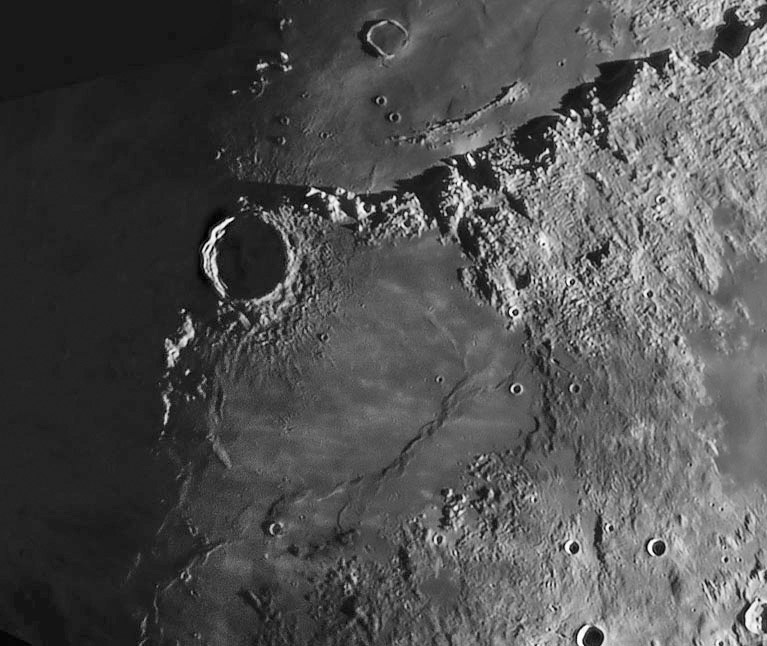Difference between revisions of "January 6, 2009"
(Created page with "__NOTOC__ =Two for One= <!-- ws:start:WikiTextHeadingRule:1:<h1> --> <!-- ws:start:WikiTextLocalImageRule:7:<img src="/file/view/LPOD-Jan6-08.jpg/52350103/LP...") |
|||
| (9 intermediate revisions by the same user not shown) | |||
| Line 1: | Line 1: | ||
__NOTOC__ | __NOTOC__ | ||
=Two for One= | =Two for One= | ||
| − | + | <!-- Start of content --> | |
| − | + | <!-- ws:start:WikiTextHeadingRule:1:<h1> --> | |
| − | + | <!-- ws:start:WikiTextLocalImageRule:7:<img src="/file/view/LPOD-Jan6-08.jpg/52350103/LPOD-Jan6-08.jpg" alt="" title="" /> -->[[File:LPOD-Jan6-08.jpg|LPOD-Jan6-08.jpg]]<!-- ws:end:WikiTextLocalImageRule:7 --><br /> | |
<em>image by [mailto:patricio@geo.ucm.es Patricio Dominguez], Madrid, Spain</em><br /> | <em>image by [mailto:patricio@geo.ucm.es Patricio Dominguez], Madrid, Spain</em><br /> | ||
<br /> | <br /> | ||
| − | Sinus Aestuum has a conspicuous and almost straight mare wrinkle ridge running SW-NE along its SE margin. This is widely commented [mailto:patricio@geo.ucm.es Patricio Dominguez]</em><br /> | + | Sinus Aestuum has a conspicuous and almost straight mare wrinkle ridge running SW-NE along its SE margin. This is widely commented [[February_8,_2005|on]]. What is less common is the [[August_12,_2007|photograph]]. However it is not just the internal ring but all the mare surface NW to the braid-like ridge that has subsided. Some radial and tangential structures may be traces of block tectonics. That suggest that the development of block tectonics after the Imbrium impact in the Montes Appeninus and beyond. In this sense the Rima Bode II and its continuation towards the NE margin of Sinus Aestuum southern Marco Polo, could be the margin of two of these blocks. The dark mantle material east of Sinus Aestuum could be explained as a result of the volcanism generated after such block-tectonics.<br /> |
| + | <br /> | ||
| + | <em>[mailto:patricio@geo.ucm.es Patricio Dominguez]</em><br /> | ||
<br /> | <br /> | ||
<strong>Technical Details</strong><br /> | <strong>Technical Details</strong><br /> | ||
| Line 13: | Line 15: | ||
<br /> | <br /> | ||
<strong>Related Links</strong><br /> | <strong>Related Links</strong><br /> | ||
| − | Rükl plate [ | + | Rükl plate [https://the-moon.us/wiki/Rükl_32 32]<br /> |
<br /> | <br /> | ||
| + | <p><b>Yesterday's LPOD:</b> [[January 5, 2009|Visualization of an Unimportant Crater]] </p> | ||
| + | <p><b>Tomorrow's LPOD:</b> [[January 7, 2009|Whose Rilles?]] </p> | ||
<hr /> | <hr /> | ||
| − | + | {{wiki/ArticleFooter}} | |
| − | |||
| − | |||
| − | |||
Latest revision as of 19:44, 18 August 2018
Two for One

image by Patricio Dominguez, Madrid, Spain
Sinus Aestuum has a conspicuous and almost straight mare wrinkle ridge running SW-NE along its SE margin. This is widely commented on. What is less common is the photograph. However it is not just the internal ring but all the mare surface NW to the braid-like ridge that has subsided. Some radial and tangential structures may be traces of block tectonics. That suggest that the development of block tectonics after the Imbrium impact in the Montes Appeninus and beyond. In this sense the Rima Bode II and its continuation towards the NE margin of Sinus Aestuum southern Marco Polo, could be the margin of two of these blocks. The dark mantle material east of Sinus Aestuum could be explained as a result of the volcanism generated after such block-tectonics.
Patricio Dominguez
Technical Details
The image above is a composite of two images. The first was taken January 4 when Sinus Aestuum was near the terminador, the second was taken some months ago during an almost full Moon with a similar libration. The composite image shows details of both: long shadows showing the relief and the albedo. Near terminator image: January 4, 2009 22:30 UT. Celestron CGE 800, Camera DMK 31 AF 03.AS, Infrared filter (Astronomik IR Pro 742)
Full Moon image: August 20, 2008 01:30UT. Celestron C8 (1978) on HEQ5 Camera DMK 31 AF 03.AS, Infrared filter (Astronomik IR Pro 742)
Related Links
Rükl plate 32
Yesterday's LPOD: Visualization of an Unimportant Crater
Tomorrow's LPOD: Whose Rilles?
COMMENTS?
Register, Log in, and join in the comments.



